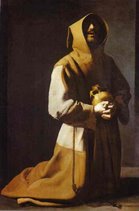
Or not quite.
This past Saturday, A.V. and I visited the
The museum, which boasts "the largest collection of Egyptian-inspired artifacts in the
I must also praise the gift shop – if you have ever yearned for a 5 inch statue of Anubis, or for one of those foot long reproductions of an Egyptian raft on the
The real highlight was the 35-minute planetarium show - “The Mithraic Mysteries.” Anyone who has watched a documentary special on the nativity of Jesus knows that (ahem) December 25th was chosen as the birthday of the Messiah to coincide (ahem) with the celebration for Sol Invictus, a possible title for Mithras, not to be confused with the Persian god Mithra, who also, according to all those documentaries, bears an eerie resemblance to Jesus in his origin, life, and death. Mithraism (surrounding Mithras, who according to most recent scholarship was not directly related to Mithra) was a mystery religion especially popular among Roman soldiers; all that really remains is their iconography. The most famous example, the tauroctony, was the subject of the planetarium show. Derived from David Ulansey’s book, the show explains that the tauroctony may have had astronomical meanings – Mithras is actually Perseus, complete with Phrygian cap, gazing away from the bull (Taurus) that he kills beneath him. The other symbols – the dog (Canis Minor), scorpion (Scorpio), bird (Corvus), and snake (Hydra) likewise have their constellation counterparts. The two boys often featured on the sides, one with torch held up, the other with torch held down, correspond to the crossing of the sun through the celestial equator. Why would they depict the night sky in such a way? According to Ulansey, Mithraism developed in the first century B.C. in Asia Minor, shortly after the discovery by Greek astronomer Hipparchus of precession – the change in direction in the axis of the earth that most obviously causes our “North Star” to change over thousands of years, but also causes the celestial equator to cross the zodiac at a different location during the spring and fall equinoxes every couple thousand years. At the time of his discovery, however, it was believed that the earth was fixed, with various arcs and celestial spheres moving around it. Hipparchus had therefore discovered a new ‘force’ that moved the spheres around the earth, a force that may have been associated with Plato’s 'hypercosmic sun' existing outside the known universe. The tauroctony depicts the constellations that the celestial equator passed through during the Age of Taurus, about 5000 years ago. (The representations in the constellations most likely had additional meanings that played a part in the beliefs about the world and the rituals that believers performed.)
It’s a bit amusing to speculate that the participants in the Mithraic cult were actually worshipping precession, the silly pagans. But it also shows the spread and importance of the Platonic belief that the soul would descend at birth, and ascend at death, through the heavenly spheres to the One that exists outside of creation, and provides clues as to why Christianity may have been seen as especially attractive to converts.
We didn't get into any conversations with Rosicrucians, unfortunately. We did pick up their nice brochure, and peruse the books in the gift shop - nothing quite like books by 20th century mystics about the secret mysteries of Christ! - but the Rosicrucians got to keep their own mysteries.


7 comments:
As far as planetarium shows went, it was a bit bizarre, but somewhat interesting. I was eager to see how they were going to present the ideas of an ancient, esoteric religion to a bunch of 21st century families with a bunch of kids in tow. They did a good job, all things considered.
As a fan of Neoplatonic pagan religion, I came away thinking that Mithraism was a a religion of upstarts; maybe like the Heaven's Gate cult with more street cred and less suicidal tendencies. And the science of it all, as usual, was a little hard for me to follow. :(
You also failed to mention the three or four quinceanera parties that went their to take their pictures. A little bit tacky, if you ask me.
First the Mormon temple and now the Rosicrucian place. Y'all are sure gettin' around, huh?
I also wanted to rub the hippo's stomach seen in the picture, but then I would have definitely gotten in trouble.
...maybe that was my aversion to all the children running around...
I had no idea you suffered from kidophobia! Perhaps I will spare you from my Two Terrors when we head up to SJ in March. :-)
crimsoncatholic, I have an aversion to children running wildly around, to make a distinction. At the museum were several cases of a parent absorbed in some reading material at a display while their child/children ran around the room, getting between adults and other exhibits, playing with the audiovisuals on certain displays, and even getting into fights with other kids, with the parent nonchalantly saying, "if you don't behave, we're going to leave" and then tuning their kid/s out for the next ten minutes as their kid started to push/shove/kick someone else's kid. And while child-friendly, this really isn't a children's museum.
Strangers don't want to be forced to babysit your kids in a museum, people! If they are high energy, bring them to appropriate venues! And if you don't want to discipline 'em, don't have 'em! (You can see that it's a major pet peeve of mind.)
You are welcome to bring your well-behaved angels around me anytime! :-)
Post a Comment